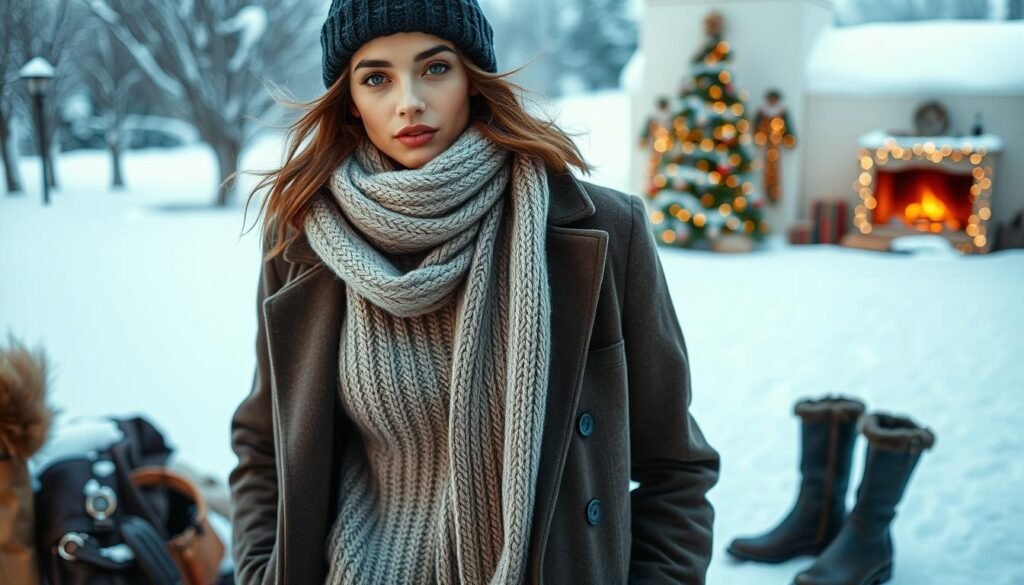“Fashion is what you buy. Style is what you do with it,” said legendary designer Diana Vreeland. This wisdom is key when it’s cold and we must choose between looking good and staying warm.
You don’t have to give up your style for big coats and loose layers. Winter fashion can be both useful and stylish if you know how. Experts from places like Colorado show us how to make winter outfits that work in tough weather.
Forget the fear of swapping your favorite clothes for ugly cold weather gear. This guide shows you how to stay warm and stylish. You’ll learn about layering, picking the right fabrics, and more. Discover how to make cold weather looks that boost your confidence all season.
Key Takeaways
- Layering strategically allows you to stay warm while maintaining your personal style
- Choosing the right fabrics and textures makes a significant difference in both warmth and appearance
- Accessories can elevate basic pieces and add personality to cold weather ensembles
- Proper fit is key – well-fitted layers look better than oversized clothes
- Investing in quality outerwear pieces creates a foundation for multiple stylish looks
- Color coordination and thoughtful styling prevent the “bundled up” appearance
Understanding Winter Fashion Fundamentals
Mastering winter fashion means knowing the basics that keep you warm and stylish. It’s not a choice between being warm or fashionable. It’s about finding a balance that meets your needs and keeps your style intact.
The Balance Between Warmth and Style
Finding the right mix of warmth and style is key. Look for pieces that do double duty. A fitted wool coat keeps you warm and looks great.
Choose fabrics like merino wool or cashmere for their warmth without bulk.
Smart layering techniques let you adjust your outfit as the day goes on. You can add or remove layers to stay comfortable and stylish.
Climate Considerations for Your Region
Knowing your local climate is essential for good winter fashion. Different places have different needs. Think about:
- Average winter temperatures in your area
- Humidity levels and wind patterns
- Indoor heating situations you’ll encounter
- Your typical winter activities and commute
Setting Your Winter Wardrobe Budget
Smart budgeting changes how you shop for warm styling. Spend more on key items like good base layers, a versatile coat, and reliable boots. These pieces are worth the investment.
Think about how often you’ll wear something. A $200 coat worn 50 times costs just $4 per wear. It’s more cost-effective than buying cheaper items.
Building Your Base Layer Foundation
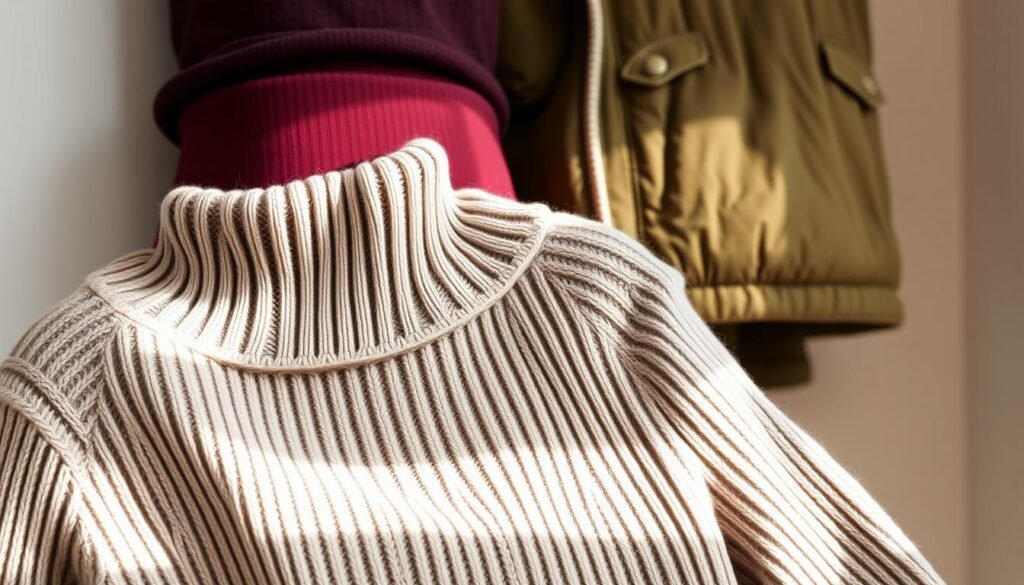
Your base layer is like a secret ingredient that makes your winter outfits both warm and stylish. It’s the first layer that affects how well you stay warm. Choosing the right one means you can stay cozy without losing your personal style.
Think of your base layer as your cold-weather secret weapon. It works quietly to keep your body temperature right and manage moisture. The right choice helps all your layers work together better.
Choosing the Right Thermal Underwear
Quality thermal underwear is key to staying comfortable. UNIQLO’s HEATTECH technology is a top choice for base layers. These are thin but keep you warm.
Look for thermal underwear that’s soft and keeps its shape after washing. It should fit well but not feel tight. You want it to move with you all day.
Moisture-Wicking Materials That Work
Moisture-wicking fabrics are great at keeping you dry. They pull sweat away from your skin. Synthetic blends and treated natural fibers are good at this.
Stay away from cotton base layers because they hold moisture and lose warmth when wet. Instead, pick materials that move moisture to the outside. This keeps you warm and dry during temperature changes.
Proper Fit and Comfort Guidelines
Your base layer should fit like a second skin. Proper fit means smooth coverage that doesn’t get in the way of your outer layers. Look for features like scoop necklines that stay hidden.
Think about sleeve length – slightly shorter sleeves are best. Always tuck your base layer into your pants for better insulation. This simple step keeps cold air out.
Mastering the Art of Strategic Layering
The secret to stunning cold weather looks is in mastering layering. This turns simple pieces into stylish outfits. It also keeps you warm and flexible all day.
Choosing the right pieces is key. They should fit well together, not look bulky. This way, you avoid looking like a walking sleeping bag.
The Three-Layer System Explained
Expert warm styling uses a three-layer system. Your base layer pulls moisture away from your skin. Use materials like merino wool or synthetic blends.
The middle layer keeps you warm with sweaters or fleece. Your outer layer protects you from the elements. This setup lets you adjust as the temperature changes.
Managing Proportions and Silhouettes
Creating flattering winter outfits means paying attention to fit. Wear fitted base layers, then looser middle pieces, and finish with a structured coat. This avoids the “stuffed sausage” look.
Balance your look by varying the fit of each layer. A slim turtleneck works well under a relaxed cardigan, topped with a tailored coat.
Mixing Textures and Patterns Successfully
Texture mixing adds interest to your look. Mix smooth fabrics like silk with textured items like cable-knit sweaters.
Combining Different Fabric Weights
Wear lightweight fabrics next to your skin, medium-weight in the middle, and thick outer coats. This creates a balanced look that’s polished.
Pattern Mixing Do’s and Don’ts
Begin with a solid color base when mixing patterns. Stripes and solids work well together. Subtle textures add depth. But, don’t mix more than two bold patterns in one cold weather look to stay stylish.
Selecting Winter-Appropriate Fabrics
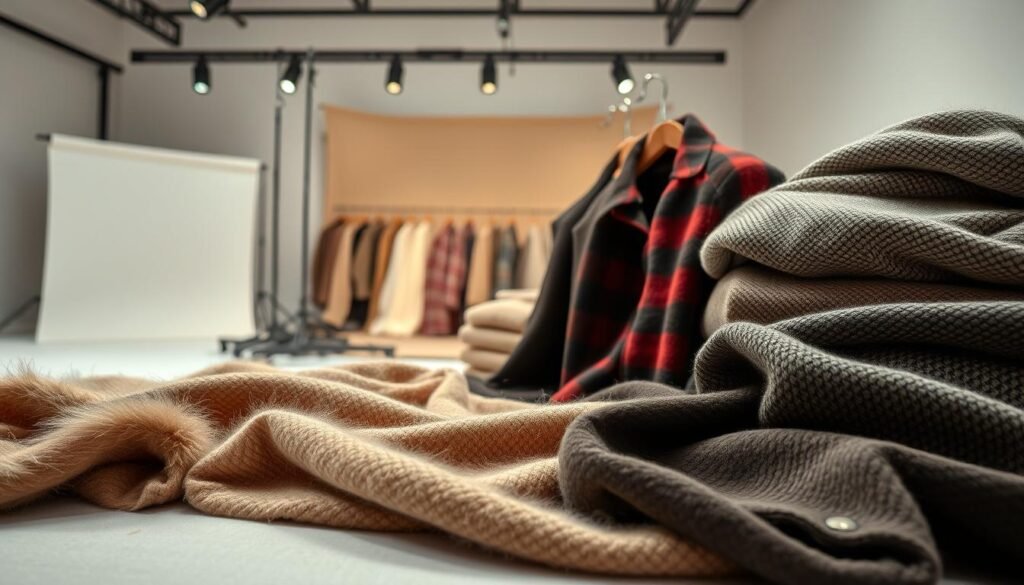
Choosing the right fabrics makes winter outfits stylish and comfy. The right materials keep you warm and look good. Knowing about fabrics helps you pick clothes that are both warm and stylish.
Natural vs Synthetic Material Benefits
Natural fibers like wool and cotton are great for winter fashion. They keep you cool and dry. Wool is good at wicking away moisture and staying warm.
Synthetic materials are good at keeping you dry and lasting long. They dry fast and keep their shape. They’re also cheaper than natural fibers but work well in challenging weather conditions.
Wool, Cashmere, and Down Options
Cashmere is three times warmer than regular wool but feels light. It makes clothes look sleek without being too heavy. Merino wool is great for keeping you at the right temperature and smells fresh.
Down is very warm and light for outer layers. Down jackets are small but keep you warm. When looking for the best winter fabrics, think about down’s convenience for traveling.
Breathable Yet Insulating Choices
The best winter fabrics are warm but also let you breathe. Wool blends mix natural and synthetic fibers for the best of both worlds. They’re perfect for staying warm without getting too hot.
Technical fabrics are great for keeping you warm and dry. They’re perfect for base layers and active winter clothes.
Care Instructions for Different Fabrics
Looking after your fabrics makes them last longer. Cashmere needs gentle hand washing or professional cleaning. Down items need special drying with tennis balls to keep them fluffy.
Synthetic fabrics have special washing needs. Always check the care labels to keep your clothes in top shape.
Choosing the Perfect Winter Coat
The right winter coat is key to stylish cold weather looks. It shapes your winter wardrobe and boosts your confidence. Quality construction and thoughtful design ensure a coat lasts for years, not just one season.
Coat Styles for Different Body Types
Your body shape determines the best coat style for you. Wrap-style coats create a defined waistline, flattering most figures. Straight-cut designs are great for petite frames, with clean lines.
Statement pieces like leopard print coats can make simple outfits stand out. Bold patterns and rich colors add polish to basic layers.
Length and Coverage Considerations
Coat length affects both warmth and style. Coats that reach your thighs or knees offer better protection than hip-length ones. Longer styles also add elegance to your winter outfits.
Think about your lifestyle when picking coat length. Knee-length coats are good for commuting and office settings. Mid-thigh options are versatile for both casual and professional looks.
Essential Features to Look For
Smart features make winter coats both functional and stylish. Look for these key elements:
- Two-way zippers for temperature control and easier movement
- Deep pockets for warming hands and storing essentials
- Quality insulation for your climate
- Durable outer shell materials
Pockets, Hoods, and Closures
Practical details make daily wear more comfortable. Multiple pocket options keep hands warm and belongings secure. Hoods add versatility but consider if they fit your style.
Reliable closures are key in harsh weather. Quality zippers, snaps, and buttons should withstand frequent use and look good all season.
Creating Stylish Winter Outfits for Every Occasion

Creating stylish cold weather looks needs careful planning for different activities. Your clothes should fit well whether you’re going to work, running errands, or going to events. It’s all about having versatile pieces that work in many settings.
Smart winter fashion is about more than just clothes. Think about how each item works from cold outside to warm inside. This way, you stay comfy and stylish all day.
Professional Work Looks
Office winter outfits need to be both stylish and practical. Start with good base layers that won’t show. Then, layer a nice sweater or blouse over thermal underwear for warmth without bulk.
Choose a sleek wool coat that looks good when you take it off indoors. Structured blazers look great over lightweight sweaters. This mix makes you look sharp from your commute to meetings.
“The best professional winter looks are those that maintain their elegance whether you’re bundled up outside or presenting in a heated boardroom.”
Casual Weekend Styling
Weekend warm styling lets you get creative with textures and colors. Try cozy cashmere sweaters with fitted jeans for a relaxed yet stylish look. A bold coat can make even simple outfits stand out for errands or coffee.
Look for comfort without losing style. Chunky knits and soft scarves add interest while keeping you warm outdoors.
Evening and Social Events
For evening events, choose lighter fabrics that won’t make you too hot in restaurants. Elegant wraps are great for moving between outside and inside. Accessories add sparkle without adding bulk under your coat.
Winter fashion for social events focuses on looking good while staying comfortable in changing temperatures.
Active and Outdoor Adventures
For outdoor activities, layering is key. Use moisture-wicking base layers, insulating middle layers, and waterproof outer shells. This keeps you dry and comfy during active times.
The beauty of well-thought-out winter outfits is their versatility. Many pieces work for different occasions, so you don’t need separate wardrobes for each activity.
Selecting Footwear That Works and Looks Great
Your winter footwear choices can make a big difference in your cold weather look. The right winter boots are key to both staying warm and looking good. They provide the protection you need while adding to your style.
Choosing the right boots means finding a balance between function and fashion. Your feet need boots that are comfortable in cold weather and match your winter outfits well.
Boot Styles for Function and Fashion
Knee-high boots are warmer than ankle boots because they cover more of your leg. They’re great for both work and play.
Sneaker booties with faux fur lining are perfect for milder winters. They’re comfy and stylish. Block heels add a touch of elegance without sacrificing stability.
Traction and Waterproofing Features
Good winter boots have deep treads and waterproof membranes to handle snow and ice. Sorel boots are a great example of boots that are both stylish and practical.
Look for boots with insulated linings that keep your feet warm but also breathe. These features help you stay comfortable and confident all winter.
Transitioning from Outdoors to Indoors
The best winter boots are easy to wear from outside to inside. Look for styles with removable linings or designs that are stylish but not too utilitarian.
Choose boots that are built to last through many winters. Pick styles that complement your winter fashion without overpowering it.
| Boot Type | Best Weather Conditions | Style Versatility | Key Features |
|---|---|---|---|
| Knee-High Boots | Moderate to severe cold | High – office to casual | Maximum leg coverage, various heel heights |
| Waterproof Winter Boots | Snow, sleet, slush | Medium – outdoor focused | Deep tread, insulation, moisture protection |
| Sneaker Booties | Mild winter conditions | High – casual versatility | Faux fur lining, ankle coverage, comfort |
| Heeled Winter Boots | Dry to light snow | High – dressy occasions | Block heels, style emphasis, moderate warmth |
Accessorizing with Essential Winter Pieces
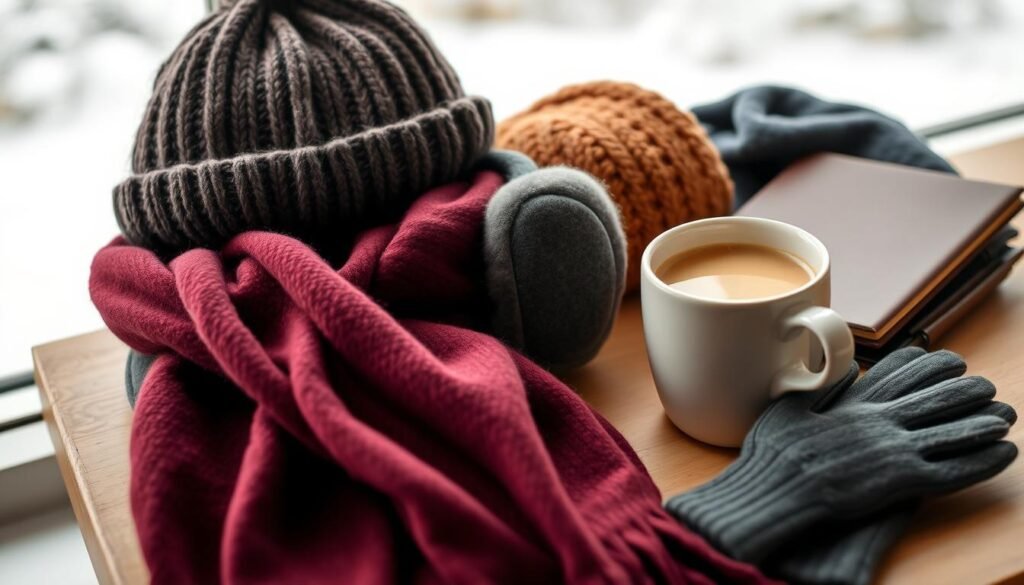
The right winter accessories keep you warm and stylish. They turn simple layers into chic outfits that show off your style. Quality accessories make the difference between looking bundled up and stylish.
Scarves, Hats, and Gloves Coordination
Matching accessories make your winter outfits look planned. Pick pieces in the same color or matching sets for easy coordination. Cashmere-lined gloves are warm and let you use your phone.
Big knit scarves add texture and interest to coats. Pearl-embellished beanies add a touch of femininity. These details warm you up and make your outfit better.
Bags and Purses for Cold Weather
Cold weather bags must be practical and work with big coats. Look for weather-resistant materials and straps that stay put. Inside, you need easy access to things when your hands are in gloves.
Go for structured bags that stay in shape in the cold. Crossbody bags are great with big coats, keeping your hands free.
Statement Pieces That Elevate Your Look
Bold accessories brighten up winter days and show your personality. A hot pink cashmere wrap or leopard-print gloves grab attention. These pieces show that warm styling can be stylish too.
Don’t forget about socks as key accessories. Cashmere socks keep you warm and feel luxurious, making your day better.
Jewelry and Winter Outfits
Winter jewelry needs to work with layers. Statement earrings pop when your hair is in a hat. Choose pieces that go with high necklines from scarves and turtlenecks. Layered bracelets should fit when you take off your gloves, keeping your winter fashion look.
Mastering Color Coordination in Cold Weather
Winter fashion doesn’t mean giving up bright colors. You can mix seasonal palettes with mood-boosting elements to fight off winter’s gloom.
Choosing colors wisely in winter outfits is key. It makes your look feel bright and purposeful, not just stuck in a season.
Working with Darker Winter Palettes
Darker winter colors offer sophisticated foundations. They go beyond just black and gray. Think deep burgundy, forest green, and navy for a rich look.
These colors match winter’s light well. They also let you layer textures and add pops of color easily.
Adding Strategic Pops of Color
For accent colors, pick one or two bold pieces. A bright scarf with a neutral coat or bold boots with simple layers can change your look.
Try leopard print or warm colors with faux fur. They add interest and keep your look stylish and cold-weather ready.
Neutral Combinations That Always Work
Neutral combos are effortless elegance. Camel and cream, gray and white, or navy and beige are always chic.
These pairs are great for adding accessories or statement pieces. They keep your winter style both practical and fashionable.
Styling Winter Outfits for Different Body Types
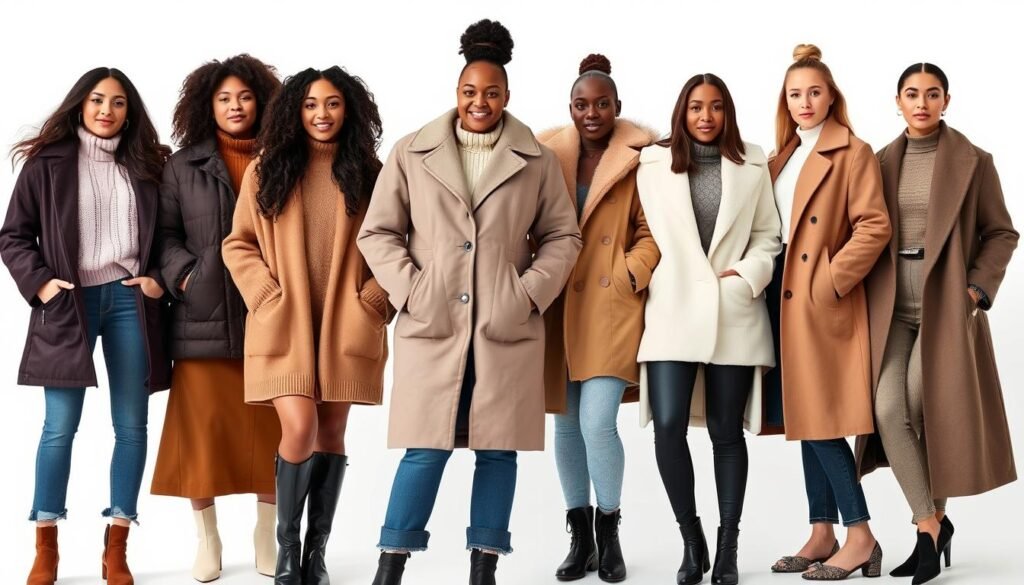
Layering smartly can make your body look great even when it’s cold. It’s all about picking pieces that flatter your shape, not hide it under too many layers.
Start with the right base pieces that match your body type. This way, you avoid looking like you’re wearing a big sausage. You’ll stay both warm and stylish all winter.
Flattering Layering Techniques for Every Figure
If you’re apple-shaped, use long coats and structured blazers to make you look taller. Choose clothes that skim over your midsection, not add bulk.
Pear-shaped folks should focus on the top half. Go for fitted sweaters, bold scarves, or textured coats. These draw the eye up and keep your lower layers smooth.
Hourglass figures look best in belted coats and fitted sweaters. Use tucking and waist-defining pieces to keep your shape in check, even in thick winter outfits.
Creating Visual Balance and Proportion
Mixing textures, weights, and sizes is key to balance. Pair slim base layers with structured outerwear for depth without overwhelming your look.
Think about how colors and patterns work together. Darker shades can slim you down, while bright colors can highlight your best features.
| Body Type | Focus Area | Best Techniques | Avoid |
|---|---|---|---|
| Apple | Create vertical lines | Long coats, structured blazers | Bulk around midsection |
| Pear | Emphasize upper body | Statement scarves, textured tops | Tight lower layers |
| Hourglass | Define waist | Belted coats, fitted sweaters | Shapeless outer layers |
| Athletic | Add curves | Textured fabrics, horizontal patterns | Boxy, straight cuts |
Emphasizing Your Best Features
Wear V-neck sweaters to make your neck look longer and more elegant. This simple choice can make your cold weather looks stand out.
Choose coat lengths that flatter your body. Whether it’s mid-thigh, knee-length, or longer, it depends on your shape and style.
“The goal is not to hide your body in winter, but to celebrate it with thoughtful layering choices.”
Use accessories to draw attention where you want it. A nice scarf can highlight your face, while the right bag can balance your look.
Avoiding Common Winter Fashion Mistakes
Many people make winter fashion mistakes that affect both comfort and style. These errors can ruin your carefully planned outfits. Knowing these common mistakes helps you create better, more comfortable looks all season.
The secret to great winter fashion is making smart choices, not just adding layers. Quality over quantity should be your guide for your cold weather wardrobe.
Preventing Over-layering and Bulk Issues
Too many layers can make you feel bulky without being warmer. Instead of wearing thick sweaters, choose strategic layering with thinner, more effective pieces. A fitted thermal base layer is better than multiple loose shirts.
Choose structured pieces that keep your shape. Well-tailored coats are warmer than oversized ones that make you look shapeless.
Protecting Extremities Stylishly
Cold hands, feet, and head can make you feel chilly all over. Quality accessories protect these areas while adding to your look. Pick gloves, hats, and scarves that match your outfit colors.
Don’t overlook accessories. They should fit well with your warm styling and serve both function and fashion.
Maintaining Style Without Sacrificing Warmth
Many think warmth and style can’t go together. This leads to choosing items that are only functional but look bad. Invest in pieces that serve dual purposes – keeping you warm while looking good.
Avoid coats that are too short or accessories that don’t fit with your layers. Each piece should add to both your comfort and style.
Conclusion
Your journey to mastering winter fashion starts with taking action on these proven strategies. The difference between feeling frumpy and feeling fabulous in cold weather lies in making smart choices about your winter outfits.
Start small by investing in one quality piece that excites you. Whether it’s a statement coat or luxurious scarf, let this become the foundation for building confidence in your winter fashion choices. Each strategic addition to your wardrobe brings you closer to effortless warm styling.
Remember that creating stunning cold weather looks doesn’t require a complete wardrobe overhaul. Focus on building versatile pieces that work together seamlessly. Your base layers, outerwear, and accessories should complement each other while serving their functional purpose.
The transformation from dreading winter mornings to embracing them happens when you apply these layering techniques and fabric choices consistently. Your personal style doesn’t disappear when temperatures drop – it simply adapts and evolves.
Take these insights and make them work for your lifestyle, climate, and budget. Winter fashion becomes enjoyable when you approach it with the right knowledge and mindset. Step outside with confidence, knowing you’ve mastered the art of staying both warm and stylish.

